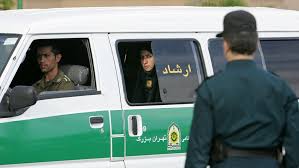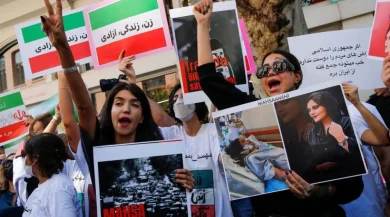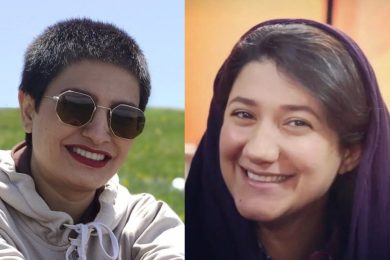In a country where free speech is criminalized and government surveillance is widespread, Iranian women have turned to social media as a powerful tool for resistance. From sharing stories of oppression to organizing protests, digital platforms have become a battleground where Iranian women challenge the Islamic Revolutionary Guard Corps (IRGC) and the regime’s authoritarian control.
This analysis explores:
• The role of social media in Iran’s women-led resistance.
• The IRGC’s digital repression tactics and how women bypass censorship.
• Key activists and online movements that are shaping the fight for freedom and equality.
• The impact of global support and how the world can stand with Iranian women in their digital fight for justice.
1. The Role of Social Media in Iran’s Women-Led Resistance
A. Social Media as a Platform for Resistance
For decades, Iranian women have been silenced, their protests suppressed by state-controlled media. However, social media has given them:
• A voice to expose human rights abuses.
• A network to organize protests and boycotts.
• A global audience to amplify their struggles beyond Iran’s borders.
Key platforms include:
• Instagram – Used for visual storytelling, sharing images and videos of protests and oppression.
• Twitter – A hub for real-time activism, trending hashtags, and breaking news.
• Telegram – A crucial secure messaging app where activists organize protests away from government surveillance.
B. The “Women, Life, Freedom” Movement Online
The 2022 uprising following Mahsa Amini’s death was largely mobilized online, with Iranian women:
• Posting videos of hijab-burning protests despite risks of arrest and violence.
• Using hashtags like #MahsaAmini, #WomenLifeFreedom, and #IranProtests to raise awareness.
• Livestreaming protests on Instagram and Twitter Spaces to counter state media propaganda.
Social media has turned local resistance into a global movement, forcing world leaders and human rights organizations to take action.
2. The IRGC’s Digital Repression: Silencing Women Online
A. Internet Shutdowns and Censorship
The IRGC controls Iran’s internet infrastructure, using:
• Nationwide blackouts during protests to cut off communication.
• Website blocking to restrict access to foreign news and social media.
• Deep packet inspection (DPI) to monitor and censor encrypted traffic.
B. Cyber Surveillance and Arrests
The IRGC’s Cyber Unit monitors and infiltrates activist networks, leading to:
• Hacking social media accounts to identify and arrest dissidents.
• Forcing activists to make televised confessions under torture.
• Tracking IP addresses to locate and imprison those who post anti-regime content.
Despite these risks, Iranian women continue to resist, using encrypted apps, VPNs, and anonymous accounts to bypass surveillance.
3. Key Figures and Movements in Digital Resistance
A. Masih Alinejad and the #MyStealthyFreedom Campaign
Exiled journalist Masih Alinejad founded #MyStealthyFreedom, encouraging women to:
• Post pictures without hijabs, defying Iran’s dress code laws.
• Share personal stories of oppression, proving that the regime’s control is not absolute.
• Use social media as a weapon against forced hijab laws.
B. WhiteWednesdays: A Symbolic Protest
• Iranian women began wearing white scarves on Wednesdays to silently protest hijab laws.
• Videos of women walking hijab-free went viral, inspiring international solidarity.
C. Niloofar Hamedi and the Fight for Press Freedom
Journalist Niloofar Hamedi, who first broke the news of Mahsa Amini’s death, used:
• Twitter to share photos from the hospital, exposing the regime’s lies.
• Digital networks to amplify the women-led protests before her arrest.
Her imprisonment symbolizes the IRGC’s fear of women who challenge the state’s narrative.
4. How Iranian Women Bypass Digital Censorship
A. Using VPNs and Encrypted Apps
• Tor, Psiphon, and Mullvad VPNs allow users to access blocked websites.
• Signal and Telegram provide secure communication channels.
B. Anonymous Social Media Accounts
• Activists use fake profiles to avoid government tracking.
• Some rely on trusted foreign allies to post content on their behalf.
C. Crowdsourcing Information to Evade Censorship
• Twitter Spaces allow real-time discussions without surveillance.
• Google Docs and external forums are used to coordinate protests.
Despite constant threats, Iranian women continue adapting, proving that digital resistance is unstoppable.
5. Global Impact and the Role of International Support
A. How the World Can Support Iran’s Digital Resistance
1. Amplify Iranian Women’s Voices
• Share their stories using #WomenLifeFreedom and #IranProtests.
• Engage with Iranian activists and journalists on social media.
2. Push for Internet Freedom in Iran
• Tech companies should provide VPNs and secure communication tools.
• Governments must challenge Iran’s internet shutdowns as human rights violations.
3. Sanction IRGC Cyber Units
• Nations should sanction IRGC officials responsible for digital repression.
• Global leaders must pressure Iran to stop persecuting online activists.
B. Why Digital Resistance Matters
Social media has transformed Iranian women’s fight for freedom into a global movement. It:
• Exposes IRGC abuses that state-controlled media hide.
• Connects Iranian activists with international allies.
• Ensures that no act of bravery goes unnoticed.
As long as Iranian women have access to the internet, their fight for freedom will continue.
Conclusion: Digital Resistance is Unstoppable
Despite censorship, arrests, and cyber warfare, Iranian women continue to resist online, proving that the IRGC cannot silence the truth. Through hashtags, encrypted communication, and global support, their voices grow stronger every day.
Join Our Newsletter!
Stay informed with the latest updates, news, and ways to take action in the fight for justice and global security. Sign up now to get updates delivered straight to your inbox!





